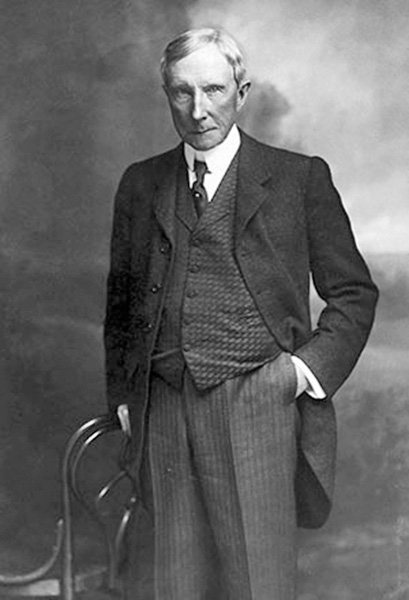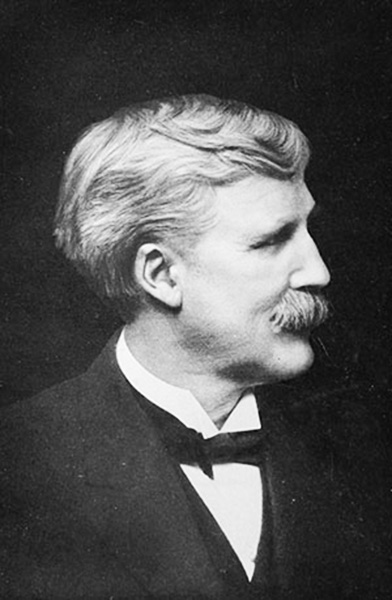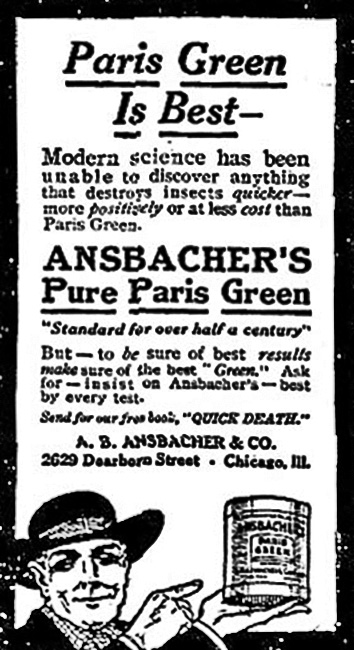|
(May-June 2021)
As a Republican,
Rockefeller
supported Abolition, back when southern
Democrat-voting industrialists profited from their human property.
He was also a Methodist/Baptist Christian who believed that god had
made him rich.
The company profited from the American Civil War (1861-65) 2 and Rockefeller used his money to establish the company that made him his fortune:
With notions of the Protestant work ethic and Christian charity, Rockefeller and his employees attempted to craft an image of the family dynasty as philanthropic...
(1839-1937)
But diary entries, papers, letters, and memos from the time confirm that the motive was primarily to make the public healthier and more educated in order to get them to work for the businesses in which Rockefeller had invested.
By the mid-20th
century, it was clear that "philanthropy" was also a massive, legal
tax dodge. 3
Although Rockefeller personally championed natural remedies, including homeopathy, publicly he funded allopathic medicine and was a major cog in the machine that brought America's medical practices up to Europe's technological standards.
But institutions, be they religious, corporate, or national, are not self-containing:
Rockefeller's philanthropy was de facto colonialism in countries including China and the Philippines, where the offshoots of his Foundation trained indigenous elites to use Western "scientific medicines" and lessen their traditional, natural cures.
Not all 19th century US physicians had formal qualifications.
Founded in 1846-47, the American Medical Association lobbied to ensure that physicians were qualified and trained up to particular standards. 5
But the formalization of healthcare training reinforced the race, gender, and class structure in that females, poor people, and non-whites were typically excluded. 6
In addition to producing young, white, male doctors from the middle- and upper-classes, the system also battled natural health in favour of the new "scientific medicine." 7
By contrast, the Popular
Health Movement was a natural health lobby which, in the 1850s,
sought to remove legal protections for reckless physicians.
The formalization of GP training led to monopolies.
Most medical courses were offered by just three universities:
As late as the early-20th century, US doctors typically trained in Europe.
Rockefeller modeled his health foundation on Berlin's
Koch Institute (founded 1891) and Paris's Pasteur Institute (1887).
Stiles advised on the abdominal disease hookworm, which mainly affected agricultural workers and thus Rockefeller et al.'s profits in his textiles investments.
Stiles believed that hookworm caused,
(1853-1929)
In the capitalist spirit of the age, Gates saw the human body as an amalgam of separate parts, akin to a factory.
Gates's view was that,
Gates initially advised Rockefeller's Standard Oil before promoting the magnate's health ventures.
Gates noted that at any one time, 20 per cent of staff in any given institution was home sick each day and said that,
He objected to the Rockefeller-founded University of Chicago's 1898 efforts to align with the pro-homeopathy Rush Medical College.
After studying in Germany, the bacteriologist and pathologist William H. Welch (1850-1934) co-founded the Johns Hopkins School of Hygiene and Public Health.
Gates asked Welch to run
the Rockefeller Institute for Medical Research, which by 1928 had
received $28m in funding (around $385m today). 13
The roots of the Foundation's global health hegemony were planted in the American south, where Black agricultural laborers continued to toil in cotton fields. 14
The Foundation's failed efforts to eradicate hookworms nevertheless gave the planners enough confidence that their work could be exported.
But their methods sought
to integrate foreign traditional healers into "scientific" medical
practices.
But Rockefeller opposed domestic natural medicines; at least for the public.
For example, it was only when the supply of the drug thymol was disrupted by the First World War (1914-18) that Rockefeller's IHB gave patients oil of chenopodium (the flower of the goosefoot plant).
With zero ethical protocols in place, Rockefeller's doctors poisoned to death 222 children with the oil between 1914 and 1932, something that natural healers were unlikely to have done. 15
The International Health
Board and its successors spent billions of dollars (tens of billions
in today's money) in over 100 countries, establishing 25 schools and
institutes, and sponsoring over 2,500 nurseries. 16
At the time, representatives of the global body, the League of Nations, described Rockefeller's International Health Board as,
The motives were profit-driven. Rockefeller Foundation President, George E. Vincent (1864-1941), said that when it came to conquering foreigners, public health had,
The Philippines International Health Commission visited the Moro tribes and acted, in the words of Foundation officers, as,
After the British Empire's occupation (circa 1842-1912), but before the economic nationalism of Chairman Mao (1893-1976), US investors sought to exploit China's huge working population and raw materials.
Rockefeller and his successors funded the Peking Union Medical College to the tune of $45m (or half a billion today).
Chinese traditional medicine includes but is not limited to acupuncture, cupping, diet, herbs, and qigong. It has been used for thousands of years and is regularly attacked in the West by advocates of Big Pharma.
Rockefeller money started
the anti-traditional medicine movement in China while taking some of
its ideas and products to synthesise them as modern drugs.
Known in Chinese medicine as ma-huang (top image), ephedra shrubs have been used for 5,000 years and were first catalogued by Emperor Shen Nung in 2700 BCE. 20
The Japanese Professor, Nagayoshi Nagai, isolated ephedrine from the shrub in 1885 to produce synthetic chemicals for blood pressure treatment. The Rockefeller-funded Peking Union Medical College took credit for isolating and synthesizing the chemical.
The Lancet reports that the College,
Today, we hear about the dangers of "vaccine nationalism." 22
Russia's Sputnik V vaccine against Sars-CoV-2 (COVID-19) was demonized by Western media 23 before being accepted as >90 per cent efficacious by Western journals. 24
The UK's
AstraZeneca-Oxford vaccine was sold to the British public as
effective, 25 yet several heads of state at the European Union, which
is promoting the US-German Pfizer-BioNTech vaccine, publicly
cautioned against the UK vaccine.
Rockefeller's International Health Board stoked controversy by pointing to side effects in yellow fever vaccines developed by rival institutes, such as the Pasteur Institute, which was operating in France's colonial subject, Tunisia.
Rockefeller's vaccines were initial failures.
The authors of an article on biological history state:
"Paris Green" was named after its use against rats in the sewers of the famous French capital.
The Bulletin of the Industrial Commission reported at the time that,
The Department of Labor described it as,
The Rockefeller International Health Board experimented in anti-malaria techniques in,
The League of Nations argued that sanitation was key to beating disease, but Rockefeller lobbyist and physician Lewis Hackett (1884-1962) argued for the use of "Paris Green."
The International Health
Board used its propaganda to promote the results of a dubious,
preliminary study in Italy.
DDT is also a toxin trialled by the US Typhus Commission.
During the Second World
War (1939-45), the Rockefeller Foundation's health institutes tested
DDT on German and Italian prisoners of war, as well as on Algerian
inmates before heralding DDT operations a success in Sardinia.
30
Disease historians note that the yellow fever virus mainly affected the nation's shipping ports that were crucial for US corporate profits, including Rockefeller's Standard Oil.
In addition to using
poison to blitz mosquitos to clear ports for profit, the Foundation
used its eugenics ideas to encourage Mexican women to produce
"strong" babies that could grow into healthy workers. 32
COMING AROUND
The so-called third world became a battleground between US imperialism and Soviet dominance, with the Rockefeller Foundation struggling to design an internationalist, post-War policy.
The giant, US, post-War machine referred to by future President Dwight D. Eisenhower as the "military-industrial complex" meant that research grants were awarded through the government's National Science Foundation, making Rockefeller money less immediately appealing to young researchers.
The Rockefeller Foundation initially succeeded by funding the shift in research from chemistry to biology, particularly the study of proteins for vaccination.
What began as schools for research turned into captive instruments that awarded funding for clear proposals, not for theoretical research.
But theoretical research
is where major breakthroughs tend to occur. 33
The Rockefeller Foundation failed to make the shift from protein to DNA research and lost ground to big biotech firms, like Monsanto (now Bayer).
But cultural changes began to take shape.
But, having been part of the mechanisms that destroy the world with their interests in oil, banking, and pesticides, the Rockefellers have now seen profit-potential in solutions to the problems they allegedly helped to create.
In more recent years, the
Foundation and Rockefeller's successors have come to recognize the
value of naturopathy.
In the Anthropocene, the dominant species causing potentially irreversible destruction to the planet's ecosystem is the human.
The Rockefeller Foundation and The Lancet published a report stating:
Having gone from seeing the human body as a factory comprised of separate parts in the 19th century and promoting molecular biology to stimulate biotech profits in the 20th, the Foundation now decries,
Sometimes, the parasitic
greed of the ruling classes destroys the host, in this case the
planet, forcing our "betters" to modify their propaganda in the new
ages they contrive.
|





